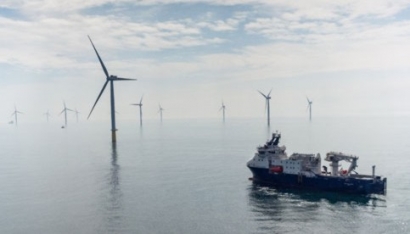
Both steps move the project closer to approval of environmental permitting by state and federal officials. Endorsement of the FEIR will be the final step in the Massachusetts Environmental Policy Act review process, which includes a focus on cables connecting the proposed 800 MW offshore wind generation in federal waters to the grid connection point in Barnstable, Massachusetts.
BOEM prepared the DEIS as part of the agency’s review of the entire Vineyard Wind project, which will be constructed 14 miles south of Martha’s Vineyard. The report provides an analysis of potential environmental impacts associated with proposed actions as set forth in the Construction and Operations Plan for the project, which Vineyard Wind submitted to BOEM in 2017.
The federal agency will hold public meetings in New Bedford, Massachusetts (Tues., Jan. 8, 2019); Narragansett, Rhode Island (Wed. January 9, 2019), Hyannis, Massachusetts (Tuesday, Jan. 15, 2019); Nantucket, Massachusetts (Wed., Jan. 16, 2019); and Vineyard Haven, Massachusetts (Thurs., Jan. 17, 2019) BOEM’s public comment period ends on January 22, 2019. Full details regarding the meetings submitting comment can be found on the Vineyard Wind webaite.
In Massachusetts, the project’s FEIR reflects refinements that have been made to the project, including many based on input from state agencies, the Town of Barnstable and members of the public. The MEPA office will accept public comment until January 25, 2019. The Massachusetts FEIR is focused on the Vineyard Wind Connector, which is comprised of subsea and subsurface electrical transmission lines and a new substation that will connect the Vineyard Wind turbine array to the Massachusetts electric grid.
The Vineyard Wind offshore wind turbine array, located approximately 34 miles south of the Cape Cod mainland, calls for a grid connection point to an existing substation in an industrial park in Barnstable with no changes to the existing electrical transmission. Vineyard Wind has stipulated that they will use solid material cables only, and that they will be buried for their entire length onshore, and also that the transformers and other electrical equipment at the new substation will be underlain by full volume, impervious containment systems.
Since its selection by Massachusetts utilities as the winning bidder in the Commonwealth’s recent offshore wind solicitation, Vineyard Wind has moved forward to obtain all necessary approvals by the summer of 2019.
In addition to federal and state permitting reviews, the project is actively consulting with tribal and local agencies, including Conservation Commissions and Planning Boards, including Barnstable where the cable will come ashore at Covell’s Beach. The project will also be reviewed by the Cape Cod and Martha’s Vineyard Commissions.
In total the Vineyard Wind project will face substantial public review and consultations by nearly 30 federal, tribal, state, and local approval agencies, including from the Army Corps of Engineers, National Marine Fisheries Service, the Massachusetts Department of Environmental Protection (MADEP) and the Massachusetts Office of Coastal Zone Management (MACZM).
Vineyard Wind, based in New Bedford, Massachusetts, is 50 percent owned by funds of Copenhagen Infrastructure Partners (CIP) and 50 percent by Avangrid Renewables.

